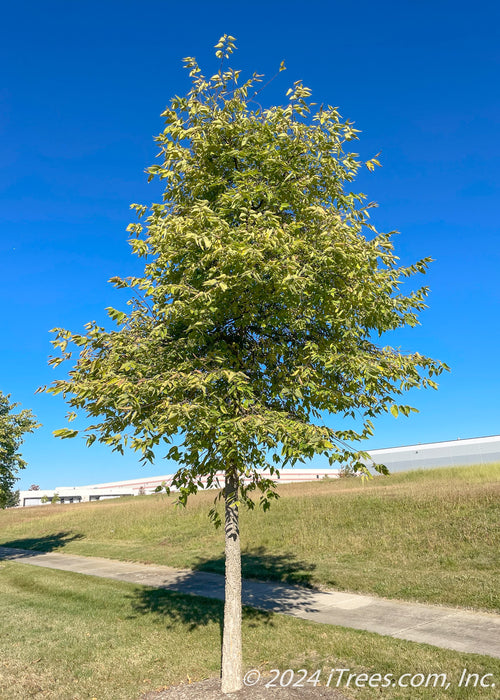

Why it rocks:
Native Hackberry is the ultimate choice for Chicago landscapes. Imagine a tree that not only withstands the unpredictable Illinois weather but thrives in it. Native Hackberry is that tree— a true champion of the Chicagoland region. Picture your yard transformed into a lush, green oasis, with Native Hackberry's generous canopy providing cool, refreshing shade on even the hottest summer days. Native Hackberry offers more than just respite from the sun. Its deeply furrowed, corky bark adds a touch of rustic elegance, a fascinating texture that brings visual interest to your landscape all year long. As the seasons change, prepare to be delighted. Delicate yellowish-green catkins appear in spring, followed by sweet, edible berries that become a magnet for songbirds, butterflies, and playful squirrels. Your yard will become a vibrant ecosystem, buzzing with life and activity. Come autumn, Native Hackberry's leaves change to a soft yellow, painting your landscape with warm, inviting hues. This tree is a powerhouse of growth. It's one of the fastest-growing trees available, meaning you won't have to wait decades to enjoy its full majesty. Even in challenging conditions where other trees falter, Hackberry stands tall and proud. If you desire a tree that combines unmatched resilience with captivating beauty, a tree that supports local wildlife and enhances your property year-round, then Native Hackberry is the perfect choice for you. It's not just a tree; it's an investment in your home, your happiness, and the environment.
Where to put it:
Native Hackberry is a magnificent shade tree that flourishes best in areas where its impressive size and beautiful native characteristics can be admired throughout the seasons. Consider planting it in spacious sections of your landscape or in more naturalized backyard settings to create an intriguing backdrop for your home. For optimal energy efficiency, it is recommended to position this tree on the east, west, or northwest side of your residence. It also thrives in parkways and is commonly found in city parks and in cemeteries. Make sure to plant it 20 to 25 feet away from buildings to allow sufficient room for its full mature spread to flourish.
What it needs:
Native Hackberry will grow happiest in full sun to partial shade and prefers moist, well-drained soil, although it can tolerate a variety of conditions. This tree is exceptionally resilient and able to withstand dry areas, occasionally saturated sites, road salt, urban pollution, air pollution, and diverse soil types found in the Chicagoland area. It also exhibits remarkable heat, drought, and cold tolerance. Truly, this tree is a champion of Chicago's landscapes! Hackberry can adapt to nearly any environment. To promote a strong & healthy root system, please adhere to our tree care guidelines during the initial growing seasons.
| Botanical Name: | Celtis occidentalis |
|---|---|
| Hardiness Zone: | 3 |
| Tree Type: | Shade |
| Size Range: | Large Tree (more than 40 feet) |
| Mature Height: | 45' |
| Mature Spread: | 35' |
| Shape: | Round |
| Foliage Color: | Light Green |
| Fall Color: | Yellow/Gold |
| Flower Color: | Yellow-green Catkin |
| Decorative Fruit: | Purple Edible Berries |
| Landscape Uses: | Shade | Parkway/Street |
| Growth Rate: | Rapid |
| Plant Tolerance: | Cold-hardy & Tough |
| Standout Feature: | Native, Fast-growing, Wildlife value |
What is a Slow Release Watering Bag? It is a slow release watering system for newly planted trees. The slow release watering bag will slowly and ev...
View full detailsWhat is a DeWitt Tree Wrap?DeWitt Tree Wrap is made from polypropylene fabric and easily conforms to fit any tree shape or bark texture. Why use De...
View full details